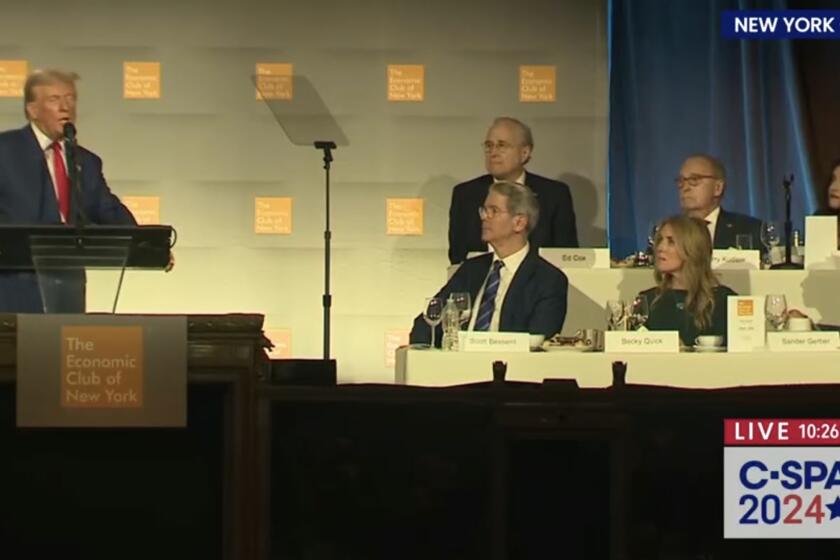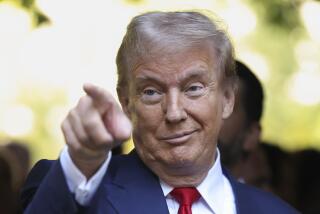Column: Trump’s glorification of the 1890s in America displays his dangerous ignorance of economics and history

Donald Trump’s firehose of fabrication and grift has reached such a peak in recent days — from his ludicrous denunciation of Kamala Harris as “mentally disabled” to his hawking of cheap, cheesy watches for $100,000 in what has been widely interpreted as an invitation to bribery to his call for one “really violent day” of unleashed police action to fight crime — that choosing a single unhinged nugget to analyze is a true challenge.
But let’s examine one that hasn’t gotten the attention it deserves: Trump’s glorification of the 1890s as the wealthiest in American history. It should go without saying that Trump couldn’t be more wrong about that. But because his remarks, uttered at a town hall session Friday in Michigan, have been largely ignored by the political media, we’ll say it.
Trump’s conception of America in the 1890s is important not merely because it displays his utter ignorance of history and economics, but because it relates to his stated economic policies in a second term — namely, high tariffs and business deregulation.
Our country in the 1890s was probably...the wealthiest it ever was.
— Donald Trump, getting history and economics very wrong
Indeed, he seems to know one thing about the 1890s in America: That it was a period of high tariffs. (Or maybe two things, the other being that William McKinley was president, though he didn’t take office until 1897.)
Here’s what Trump had to say in Michigan (repeating a theme he had mentioned at earlier rallies):
Get the latest from Michael Hiltzik
Commentary on economics and more from a Pulitzer Prize winner.
You may occasionally receive promotional content from the Los Angeles Times.
“We’re lowering taxes, we’re going to use tariffs very, very wisely. You know, our country in the 1890s was probably ... the wealthiest it ever was, because it was a system of tariffs and we had a president, you know, McKinley, right? You remember Mt. McKinley, and then they changed the name, but, uh, one of those things, but, uh, he was really a very good businessman. ... We were a very wealthy country.”
A couple of minor points: McKinley was never a “businessman.” He was a lawyer — in one of his notable cases as a private attorney, he defended 33 miners charged with rioting in a mine strike, obtaining acquittals for all but one. He served as a prosecutor, U.S. representative and governor of Ohio before reaching the White House. (He was assassinated in 1901, leading to the ascension of his vice president, Theodore Roosevelt.)
Mt. McKinley in Alaska is the former name of the highest peak in North America. It was officially renamed Denali, as the nearby Indigenous population called it, under President Obama in 2015.
The Trump campaign is promoting a healthcare solution that was tried and shown to be a failure. It would place people with preexisting conditions at mortal risk.
Now let’s take a stroll through the 1890s — the real period, not the one imagined by Trump — and ask whether this is a world to which we would wish to return. Republicans might also wish to acquaint themselves with the electoral consequences of Trumpian policies in the 1890s, which were not pretty for them.
We’ll start with a broad brush. The 1890s brought us the worst stock market crash and one of the deepest depressions up to that point. In retrospect, it was second only to the crash of 1929 and the Great Depression of the 1930s — and by some measures worse than the latter. Americans would remember it as the “Great Depression” until the 1930s economic reversal supplanted it in the economic lexicon.
In the mid-1890s, notes Paul Campos of the University of Colorado Boulder, per-capita gross domestic product shrank from $6,400 to $5,500 (in 2017 dollars). As of the second quarter this year, it was $68,977 (in 2024 dollars). In other words, no one with two brain cells to rub together could think of the 1890s as “the wealthiest America ever was.”
Certainly no one living at that time would wish to relive it. Looking back at the end of December 1893 on the year just coming to a close, the business journal Bradstreet’s Weekly called the losses suffered nationwide in “financial, commercial and industrial circles” worse than at any time in “the past eighty years.” On May 5 that year, the New York Stock Exchange had crashed by more than 24% before recovering, the worst intraday collapse until the great crash of 1929.
The year 1893 was one of two significant economic nadirs during the decade, the second coming in 1897. The latter was followed by a slow recovery that didn’t conclude until after 1900. More than 800 banks failed from 1893 through 1897, more than in any period until the Great Depression; by mid-1894, more than 150 railroad companies with 30,000 miles of track were bankrupt. The unemployment rate through the decade would ultimately approach 20%.
Historians pinpoint several causes of the stock market panic of 1893 and subsequent depression, some of which are relevant to Trump’s proposals. One was the almost complete absence of business regulation. The 1880s saw the rise of industrial combines overtly designed to suppress competition. Among the most esteemed was the National Cordage Co., or the “cordage trust,” which controlled 90% of the U.S. rope market, then a leading industry.
Trump remembers, dimly, that Marco Rubio and Ivanka Trump wanted to take your Social Security to pay for family leave, and he thinks that was a good idea.
In January 1893 the cordage trust executed a two-for-one stock split to enhance its appeal to smaller investors with a lower share price. The problem was that, like many other overgrown trusts of the era, its financial condition was opaque to its investors and even its bankers.
Only its president and treasurer knew that the cordage trust was hobbled by overproduction, a lack of credit and the evaporation of its working capital. On May 2, the trust had assured the public that it had $4 million in ready cash. In fact, the cash box held but $100,000.
The end came for Cordage on May 5, when it abruptly announced that it had been given over to bankruptcy receivers. The stock market crashed that day.
“Cordage has collapsed like a bursted meteor,” reported the Commercial and Financial Chronicle, “and the other industrials have all of them shared to a considerable extent in the decline.”
Would Trump favor returning the business landscape to the 19th century Wild West? Project 2025, the Heritage Foundation-drafted road map to a second Trump administration, calls for reducing “unnecessary regulatory impediments to capital formation” in its chapter on the Securities and Exchange Commission. Existing regulations, it says, are “ineffective, costly, opaque, and largely impervious to reform.”
In other words, the project aims to get the government off the backs of Americans, so big business can saddle up.
Another important factor in the 1890s was tariffs, which of course are a leading fixation of Trump’s.
The Tariff Act of 1890 was known as the McKinley Tariff because McKinley was chairman of the House Ways and Means Committee when it was enacted. An openly protectionist measure, it raised duties as high as 49.5% — in some cases higher than even McKinley favored. Wool and imported tinplate, which was used for ceilings and cheap cookware, were particularly targeted.
Trump and Vance claim that tariffs are paid by foreign companies and that economists are divided on the topic. They’re wrong on both counts
Americans wholly detested the tariffs, which forced up the prices of popular products. This led to an electoral bloodbath for Republicans in the 1890 midterm elections, when the party lost 78 House seats and the Democrats won a 236-vote majority. Even McKinley, who earlier had been gerrymandered into victory, lost his seat.
In the 1892 presidential election, Republican Benjamin Harrison was turned out of office and Democrat Grover Cleveland won his second term. In control of the White House and both chambers of Congress, the Democrats rolled back many of the tariffs in 1894.
After the GOP regained control of the White House and Congress in 1896, the tariffs were restored, some at even higher levels than before. Americans eventually became exasperated again with high tariffs. Democrats regained the House and cut deeply into the GOP’s Senate majority in the midterm elections of 1910, and regained the White House with the election of Woodrow Wilson in 1912. The rates were steeply lowered again in 1913.
Despite Trump’s persistent misrepresentation that tariffs are paid by the target countries, politicians in the late 19th and early 20th centuries saw them as domestic taxes by another name — and more politically palatable.
Although direct taxes can’t be concealed and always cause public debate, Wilson, as historian Joanne R. Reitano has observed, noted that “very few of us taste the tariff in our sugar.” Americans tended to tolerate tariffs until they seemed excessive, and designed to favor wealthy industrialists and bankers at the expense of farmers and laborers.
Will today’s voters have the same understanding? Or will the truth about tariffs and the political and economic conditions the McKinley tariff brought about in 1890 reach the public? Trump might not want to hope it does, because the real picture is not as pretty as he paints it. In fact, not pretty at all.
More to Read
Get the latest from Michael Hiltzik
Commentary on economics and more from a Pulitzer Prize winner.
You may occasionally receive promotional content from the Los Angeles Times.














